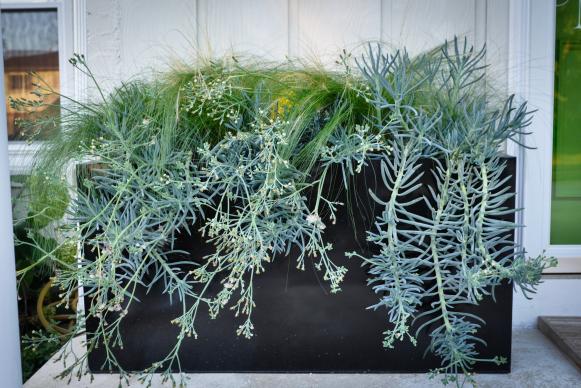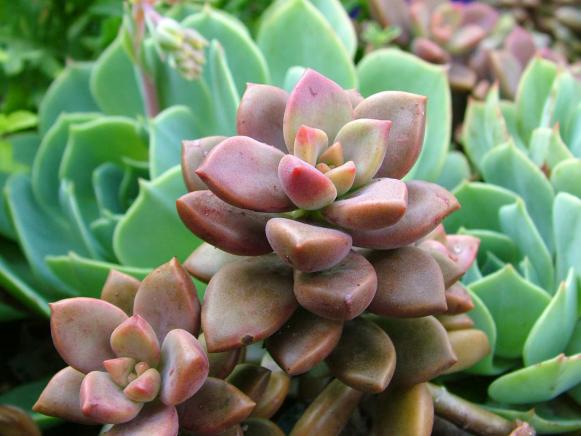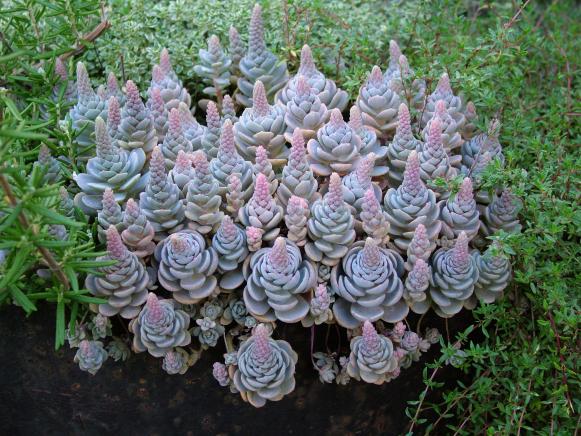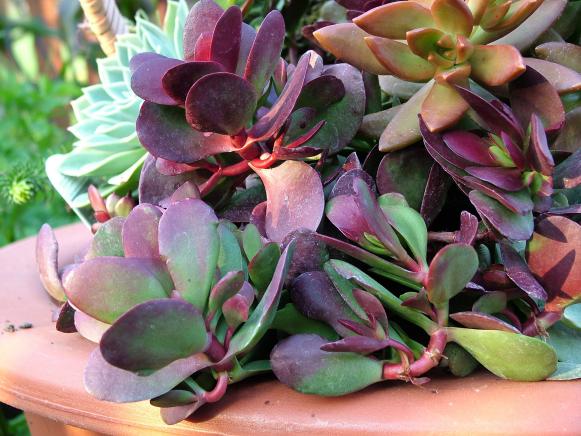Keeping succulents in pots makes it a snap to bring them indoors when cold weather hits, giving them a second life as easy-care houseplants.
With their fascinating leaf forms, interesting shapes and striking colors, succulents make great additions to any garden. The smaller kinds look especially good in containers, where you can appreciate their foliage and flowers at close range. Keeping succulents in pots also makes it a snap to bring them indoors when cold weather returns, giving them a second life as easy-care houseplants during the winter months.
Container succulents show off beautifully on decks and patios, along steps and in tabletop displays. If you give each one its own pot, you can easily move or rearrange your collection as the mood strikes you. Or you can group several different succulents in a broad, shallow container to create intricate dish gardens. Regular potting soil may stay too wet for these plants, so look for a soil-less mix that’s designed for cacti and succulents, or use a general soil-less mix blended with extra perlite (1 part perlite to 3 parts general mix).
Add texture and color to a room by using low-maintenance succulents.
Succulents thrive with lots of light, but they may develop signs of sunburn (light brown or whitish patches on their leaves) in strong summer sun, especially in Southern gardens. A site with morning sun and light afternoon shade is often ideal. If you notice that the leaves or stems of your potted succulents are getting pale and stretching out or sprawling, move them to a spot with more sun.
Succulents don’t want to have their roots constantly wet, but they don’t like to dry out completely, either. While the plants are outside, watering once or twice a week (if the plants don’t get rain) is usually fine. Those growing in tiny pots, though, may need watering as often as every other day. When you bring potted succulents indoors to protect them from frost, watering once every week or two is generally enough.
The hardest part of growing succulents may just be deciding which ones to try, because there are so many fascinating species and varieties to choose from. Here’s a sampling of just a few outstanding succulents to get you growing with these top-notch container plants.

Blue chalk sticks (Senecio mandraliscae):
This distinctive succulent grows in spiky-looking clumps of slender, gray-blue leaves. When you grow it in a container, it reaches about 1 foot tall and eventually trails over the edge. Blue chalk sticks also produce cream-colored flowers, but they’re not especially showy, and you may want to clip them off to keep the plants looking tidy.
Blue echeveria (Echeveria glauca):
Blue echeveria forms broad rosettes of closely packed powder-blue leaves. Individual rosettes are usually just 3 to 6 inches tall and wide; as they mature, they produce offsets around the original plant to create broader groupings. The nodding pink-and-yellow flowers, held on arching stems, are lovely, too.

‘Bronze’ graptosedum (xGraptosedum ‘Bronze’):
The plump, pointed leaves of ‘Bronze’ graptosedum have a unique pinkish-brown color that offers an intriguing contrast to the grays, greens and blues of many other succulents. They grow in dense whorls along stems that can reach about 8 inches tall but often lean over and cascade over the side of the container, trailing to 1 foot or more.
Coppertone sedum offers another exciting color option for succulent containers, with pointed, orangey-yellow leaves that grow in clustered rosettes, forming clumps to about 6 inches tall and spreading or trailing to 1 foot or more. Ample sunlight brings out the richest leaf color.

Dunce caps (Orostachys iwarenge):
The individual rosettes of dunce caps are quite small (just 1 to 2 inches across), but they quickly produce offsets to form a pretty patch of pale gray leaves. Through the summer, the centers of the older rosettes shoot up into 4- to 6-inch-tall, fuzzy-looking towers of white flowers. The rosettes die soon after flowering, but before then, they produce many new plantlets to keep the patch going.

‘Large Red’ red carpet jade (Crassula radicans):
Growing about 8 inches tall, ‘Large Red’ red carpet jade creates spreading clumps of roughly oval, flattened leaves. The foliage is green-edged with red in shadier conditions and heavily blushed with deep red in bright light.
Hens-and-chicks (Sempervivum tectorum):
Hens-and-chicks are hardy enough to grow in the ground in USDA Zones 4 to 11, and they make outstanding container plants too. Their dense rosettes can be anywhere from 1 to 6 inches tall and wide (sometimes even larger), with green to grayish leaves that may be tinged with pink or red, or webbed with white hairs. Mature rosettes send up thick stalks topped with starry pink flowers. They die after blooming, but they produce many baby plants that quickly fill in.
When you are ready to buy or sell your next home, please consider using CENTURY 21 Alliance Realty 352-686-0000.
Source: https://www.hgtv.com/outdoors/flowers-and-plants/growing-succulents-in-containers

No Comments